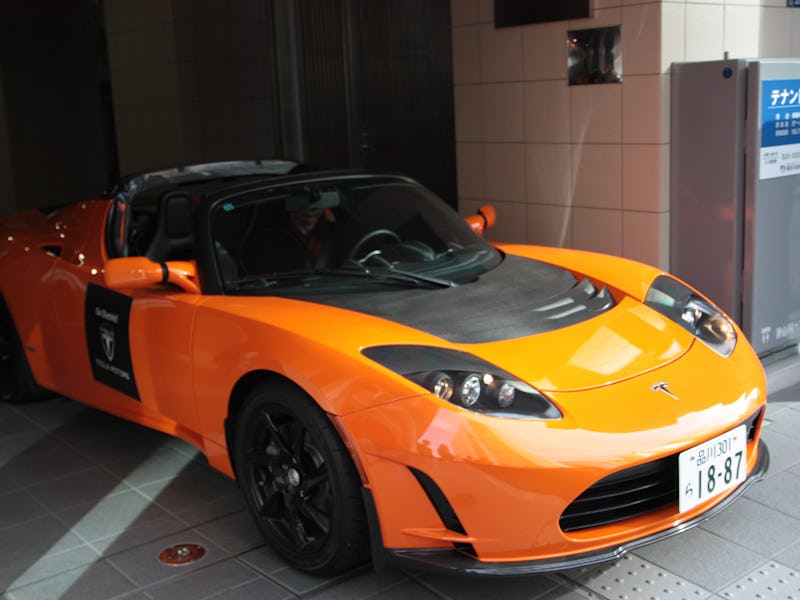A Canceled Tesla Roadster Feature Could Be the Future of EV Batteries

The electric car battery could be used for more than just getting from A to B. Industry professionals are exploring ways to use that expensive brick to charge up other appliances, get other cars back on the road, or even act as a store of renewable energy when connected to a home with solar. Tesla CEO Elon Musk revealed on Thursday that his company has actually explored alternative uses for the battery.
“Can you charge a Tesla from plugging into another Tesla?” investor Ross Gerber asked Musk on Twitter. “Can this be done easily, could be very cool if Tesla owners can charge other Teslas when low on batteries”
“Rare use case, but it is possible,” Musk wrote in response. “There are complications with this. [Early] prototype Roadsters had this ability.”
While Tesla helped to “break up the logjam” around electric vehicles, as General Motors former vice chairman Robert Lutz said in 2009, it seems the company may have dropped one of the Roadster’s most future-facing features: the ability to put that 53 kilowatt-hours to alternative uses when needed.
It’s a feature that Sono Motors’ solar-powered Sion is set to include when it reaches production later this year, while other manufacturers are taking this a step further with “vehicle-to-grid” technology that enables the car to act as a battery for the grid. Even on the smaller scale, Huawei’s Mate 20 smartphone offers the ability to wirelessly charge other devices with its battery.
As the battery in the Tesla Model S 100D is estimated to comprise $18,000 of its $79,000 asking price, it makes sense to use it more efficiently.
Tesla Roadster: How It Could Have Redefined Batteries
The Roadster set a number of firsts for electric cars. It was the first production vehicle entirely powered by a lithium-ion battery, the first all-electric sports car, first to travel more than 200 miles on a single charge, and in 2018 it became the first production car to enter space. From December 2010, when the first Chevrolet Volts and Nissan Leafs hit roads, until September 2018, over one million electric cars were sold in the United States.
Had it launched with the ability to charge other cars, it could have also broke ground on that front as well. Munich-based Sono Motors has been touting the Sion’s ability to power standard electronic devices at a rate of 3.7 kilowatts, or an electric car through a Type 2 plug at 11 kilowatts. Sono Motors depicts the car using this feature to get another car back on the move, a more advanced version of using jumper cables to get a gas-powered car fired up again.
Two Sions power-sharing.
With a household plug, the 35 kilowatt-hour Sion battery can also power a camping trip, excursions, and other off-grid activities. It’s an advancement on the cigarette lighter receptacle used in older cars to power smartphones and other gadgets, or even the USB ports found in Teslas. Good luck powering heavy machinery with five watts of juice.
More ambitious proposals could take this integration further. Tesla produces cells for its vehicles and its Powerwall and Powerpack products, the latter two of which are designed to store renewable energy from sources like wind and solar to provide a consistent source of power regardless of conditions. Tesla recommends pairing its Solar Roof with a 13.5 kilowatt-hour Powerwall for this reason. At the time of its completion in November 2017, the 100-megawatt Hornsdale Tesla battery in South Australia was the largest of its kind in the world, a scheme that is helping the state better use its resources.
Tesla's South Australia battery.
“Vehicle-to-grid” could eliminate the need for a separate battery. OVO Energy is among the first to enable using an electric car to power a home, pairing with a Nissan Leaf that has a battery of 30 kilowatt-hours or more through a special charger. A consortium that includes Octopus Energy, the firm helping to power Arsenal F.C.’s stadium from batteries, is undertaking a three-year project in the U.K. to explore the potential for V2G. UC San Diego has also conducted a pilot project with 50 V2G chargers on its campus.
Beyond aiding renewables, these vehicles could also intelligently charge and discharge at certain times of the day to take advantage of fluctuating energy prices. Research from the University of Southampton in 2015 claimed that this could result in energy bill savings of over 13 percent.
Tesla could move into these areas at a later date. During a September 2016 conference in Dubai, Ben Hill, Tesla’s vice president for energy in Europe and Africa, claimed V2G would arrive and be functional “very, very soon.” However, with the company planning to release the Model Y, Pickup Truck, Semi, and second-generation Roadster in the coming years, Tesla may already have enough on its plate to make such big changes a low priority.